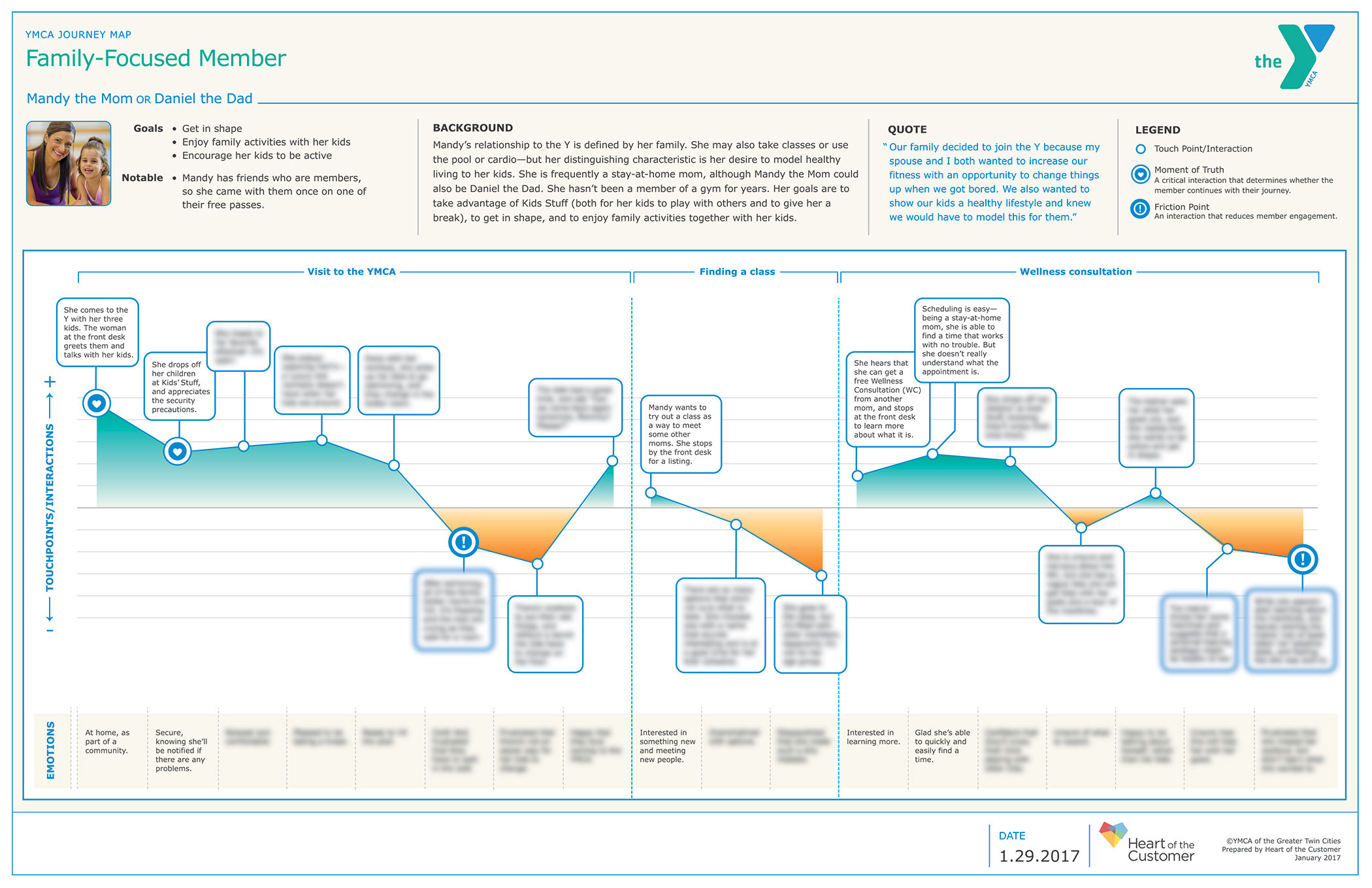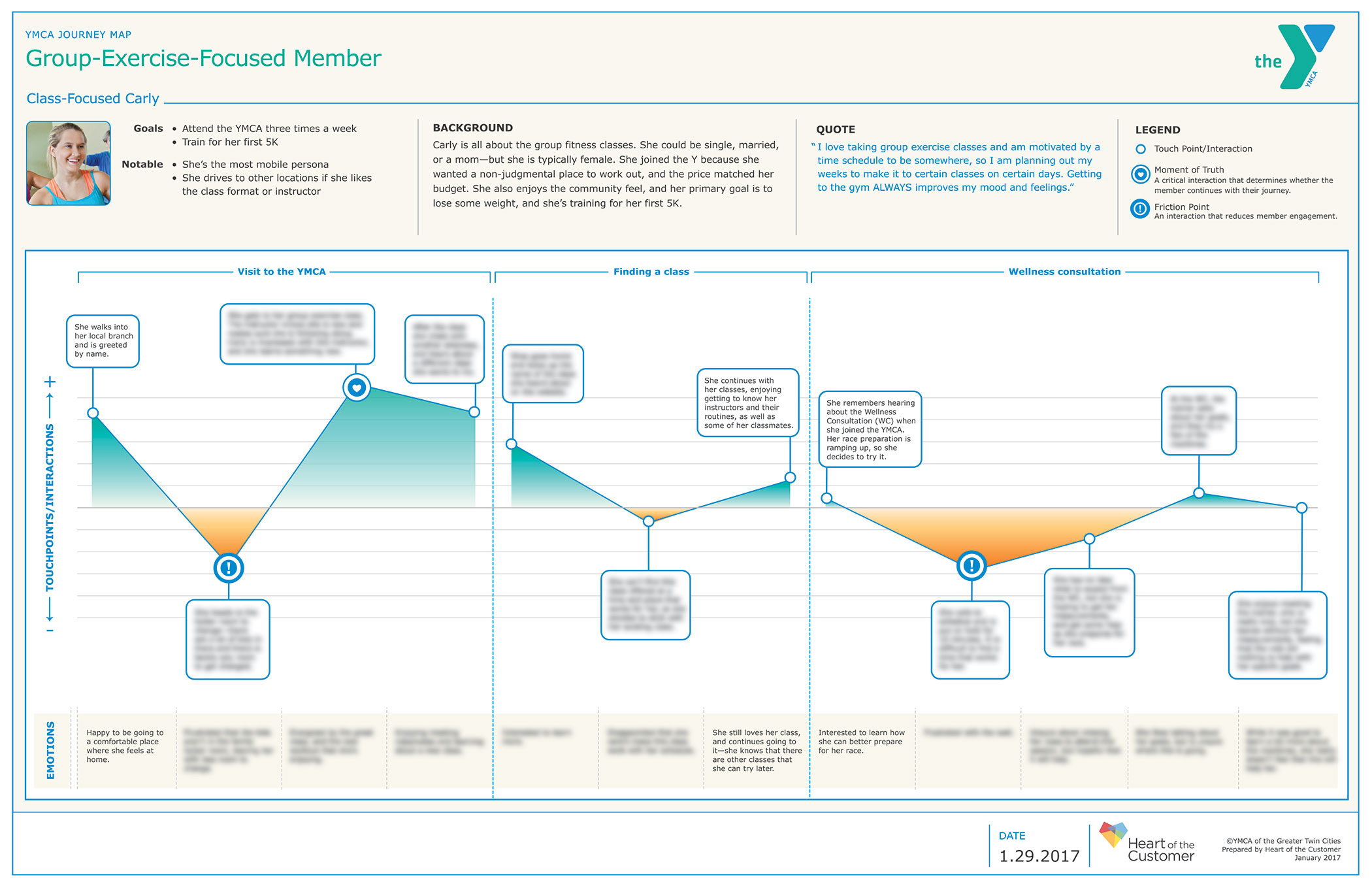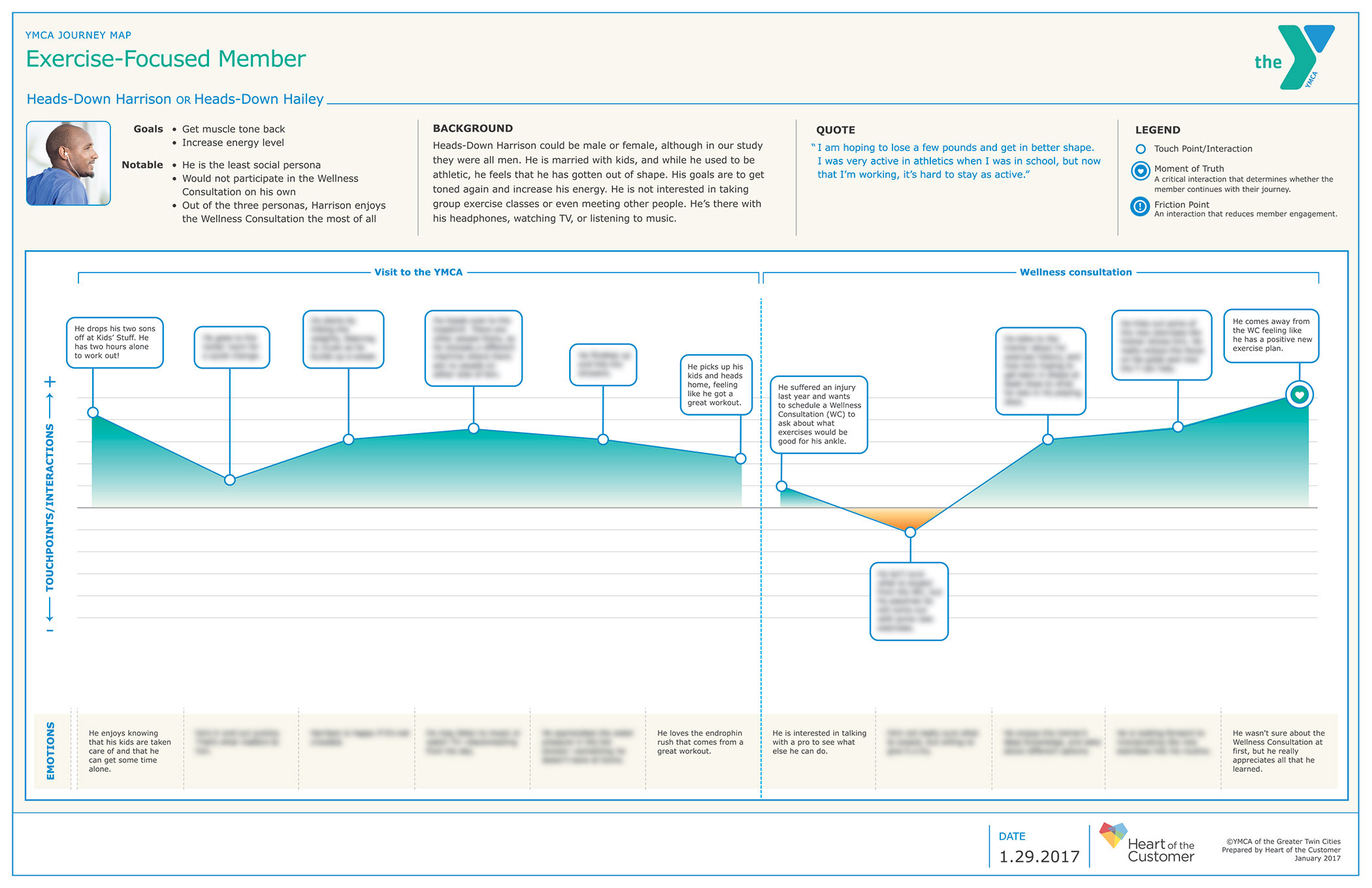Getting a grip
Editor's note: Jim Tincher is mapper-in-chief at Heart of the Customer, a Minneapolis research firm.
 The YMCA of the Greater Twin Cities, the fourth-largest Y association in the world, knew it earned high marks for programming and service overall, but recognized that its customers would be more likely to thrive, and maintain their memberships, if it learned more about the early stages of their wellness journeys. What led people to join the Y? What were their needs and expectations? What more could the Y be doing to encourage them? These were the insights that would boost member satisfaction and loyalty. But when you serve 250,000 people across the entire Minneapolis/St. Paul metropolitan area, where do you start?
The YMCA of the Greater Twin Cities, the fourth-largest Y association in the world, knew it earned high marks for programming and service overall, but recognized that its customers would be more likely to thrive, and maintain their memberships, if it learned more about the early stages of their wellness journeys. What led people to join the Y? What were their needs and expectations? What more could the Y be doing to encourage them? These were the insights that would boost member satisfaction and loyalty. But when you serve 250,000 people across the entire Minneapolis/St. Paul metropolitan area, where do you start?
Prior efforts to enhance the customer experience using Six Sigma methodology fell short. The Y experience is unique for each customer and segment, so using internal journey-mapping and quantitative data to standardize and improve performance failed to produce the desired outcome. Instead, it resulted in findings inadvertently tainted by organizational biases, and muddled operations with little interdepartmental collaboration or oversight.
Senior Director of Member Engagement Andrea Krohnberg and Chief Experience Officer Bob Thomas knew a different approach was needed. They wanted a customer-focused look at member retention that would provide valid and valuable insights into what their customers were thinking and feeling as they joined the Y community. That’s when they turned to our firm, Heart of the Customer (HoC), a Minneapolis journey-mapping and customer experience company.
We emphasized from the start that HoC’s journey-mapping process was about more than just creating a map. Each step would propel the project toward the ultimate goal: helping the Y develop cost-effective, actionable solutions.
“Jim and his team made it clear that putting the customer first would necessitate a top-to-bottom cultural shift in the organization, and interdepartmental collaboration that would require buy-in at all levels,” Krohnberg says. “To achieve that, we needed to have all our stakeholders on board from the start, so that they knew they were part of a valued cross-functional team, rather than just told what to do after the fact, without having had any input.”
Phase one: discovery
Krohnberg and Thomas identified and gathered a group of about 20, including a field team and senior executives, tapping the people best positioned to ensure the success of post-project initiatives. Guided by HoC, they reviewed existing research and trends, shared their own experiences and observations and generated hypotheses. One important takeaway from these initial meetings was that team members sometimes struggled to prioritize, because of conflicting demands imposed by multiple departments acting independently.
Once the group fine-tuned its objectives, they set out to explore the customer experience through new members’ eyes by making two fundamental decisions: the parameters of the journey and the segment of customers to include.
After careful consideration, they chose to focus on Millennial new customers – single and married members in their 20s and 30s, with and without children. The journey would encompass four branch visits and a Wellness Consultation over a three-week period, at four typical suburban branches. The selected locations represented a geographically diverse area, a range of retention rates and a wealth of desirable resources, including exercise equipment, weight rooms, swimming pools, a robust schedule of free group classes and Kids Stuff, the Y’s popular onsite free childcare, which provides safe, supervised play for kids while parents work out or relax in the building. In total, 33 participants – recruited when they joined the Y or soon after – enrolled in the study.
 Phase two: external insights
Phase two: external insights
Using mobile ethnographies to collect the empirical data meant that study participants would be able to utilize text, photos and videos to share – in real time – what they saw, felt and did before, during and after their visits to the Y (with the caveat, of course, that no images were to be recorded in the locker rooms or of other Y members). HoC customized a mobile platform to meet the study’s needs so participants could record their observations on computer or, ideally, their smartphones. They were prompted with multiple questions, starting with their reasons for joining and what it felt like to be a member. Questions about different areas of their branch, such as the pool or locker room, followed, with participants sharing their comments and rating each on a scale of 1 to 5.
This methodology also allowed the HoC team to interact with participants, to build trust, and, when warranted, probe deeper. Krohnberg and Thomas monitored the observations but didn’t have direct contact with participants. In this way, they harnessed HoC’s experience in journey-mapping and project management and freed themselves to focus on providing direction based on their knowledge of Y operations and offerings. This ensured a thorough exploration of all relevant avenues and optimized the findings without tainting them.
The result was a treasure trove of revealing qualitative data, with three distinct personas taking shape:
- class-focused customers, typically female, who were accustomed to attending a gym and joined primarily for group classes;
- customers with young children, typically less familiar with gyms, who wanted to model healthy behaviors for their kids; they enjoyed both the family time as well as time away from their children; and
- workout-focused customers, typically male, who were focused on exercising and getting in and out with few distractions.
Not surprisingly, fitness-related goals led all three personas to join the Y, with many citing the accepting, non-intimidating atmosphere as a big draw, as well as positive recollections of participating in Y programming as children. Some were also eager to meet new people, use the pool, enjoy some family time and/or train for a race.
The team saw and heard exactly how customers felt as they approached the entrance to their Y at the start of the day. “Man, it’s so early this morning and cold but I ate a lot during the Super Bowl and need to be active today,” offered one participant. They also learned that customers appreciated being greeted by name at the front desk; knowing their children would be safe and have fun in Kids Stuff while they got a break and worked out; being able to track their progress on machines; the expertise and friendliness of group class instructors; and the endorphin rush they felt after a workout.
Relatively high ratings even in areas that caused some friction indicated that despite room for improvement, customers were generally satisfied with their decision to join. Many customers felt that they didn’t have a good grasp on all the Y offers; some even unknowingly signed up for classes meant for seniors because they were confused by the schedule. Wet, crowded locker rooms were also an annoyance, along with limited open swim times and finding a favorite machine in use during peak hours.
The Wellness Consultation was the most common pain point. “It was really eye-opening to hear about the frustration caused by the gap between expectation and reality,” says Krohnberg. Customers believed it had the potential to be helpful but found it difficult to schedule and didn’t know what to expect. As a result, they came up with their own ideas about what it would include, then came away disappointed when it didn’t. The content of the consultation varied by branch and trainer, adding to the confusion. Customers wanted help devising a fitness plan, nutritional tips and baseline measurements. Instead, many left feeling that the main purpose was to sell personal-training packages.
 Phase three: journey-mapping
Phase three: journey-mapping
HoC distilled all the data into customized, informative journey maps, with graphics that made it easy to digest. The maps (see accompanying examples) showed what each persona felt and thought arriving, working out, signing up for classes and attending the Wellness Consultation, with the points of friction and moments of truth they faced along the way clearly indicated.
Phase four: action!
In the final phase, the project transitioned from data gathering to data utilization. During an all-day workshop with the initial cross-functional team (plus a few new players), HoC presented a summary of its research, a rundown of recurring themes and recommendations for focus areas most likely to boost loyalty in Millennials. HoC also shared the latest findings about customer behavior, including the science behind habit formation, the importance of ending a customer experience on a strong note (because that memory can linger longest) and the key role achieving goals and forging social connections plays in boosting customer loyalty. A series of empathy-building exercises designed to deepen understanding of the customer experience primed the team for the most important task of the day: brainstorming ideas for customer-centric initiatives based on the revelations of the journey maps.
The presentation and exercises provided rich soil in which bold, new thinking could take root. Dividing into groups, team members worked quickly at first, tossing out as many ideas as they could. The most popular ideas were then explored and expanded upon, after being reviewed, rated and prioritized by the whole team.
The result? An impressive crop of both long-term strategies and quick wins (simple but impactful changes that yield a high ROI). Tops in the quick-win column was training front-desk employees to acknowledge members on their way out as enthusiastically as they greet them when they arrive – a cost-free, easy-to-implement step that ends visits on a high note, increasing members’ desire to return. Other initiatives addressed making the class schedule easier for newbies to navigate and opening channels between branches so that customers having trouble finding the right class could easily check offerings at nearby Ys. Leveraging existing content to offer short videos with class descriptions, a suggestion made by study participants who’d seen such videos on YouTube, will also enhance the customer experience with virtually no outlay.
Discussion of more complex stratagems led the Y to devise a comprehensive 90-day welcome program, specifically designed to foster social connections and bolster nascent healthy habits. The Y is continuing on to build a proactive approach that will give new members the tools and support they need to meet workout buddies, navigate offerings and set quantifiable goals – all determinant factors of member engagement, commitment and success.
Adding a layer of governance ties these initiatives together. The active involvement of senior leadership from all relevant departments in all member-facing programs provides accountability and supervision, facilitates consistent and cooperative implementation and avoids lowering morale and overburdening team members with conflicting programs.

Trusted the brand
One last lesson learned: goodwill goes a long way. Journey-mapping not only pointed the Y toward ways to better serve new members, it steered it away from efforts that wouldn’t have paid off. Sure, customers were irritated by limited pool access or crowded locker rooms during peak periods but the granular nature of the data HoC collected showed they trusted the Y brand enough to forgive those kinds of inconveniences. With journey maps in hand, the Y was able to zero in on the friction points that really mattered and recalibrate programming to get results. Next on the agenda? In its ongoing effort to improve the member experience for all, the Y will use journey-mapping to gain the same kind of insights about existing members.
